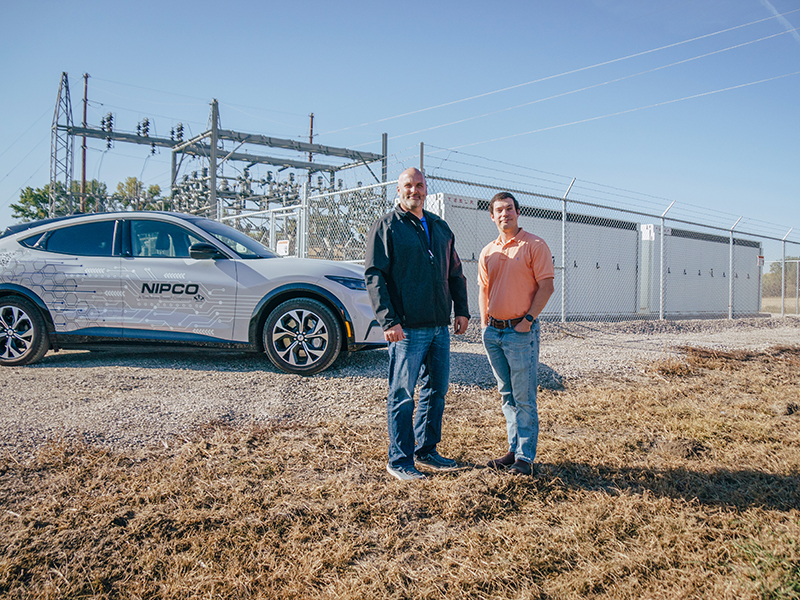Dakota Gasification Company
Headquarters:
1717 East Interstate Avenue | Bismarck, ND 58503-0564 USA
701.223.0441 | 1.800.242.2372
Great Plains Synfuels Plant
420 County Road 26
Beulah, ND 58523-9400 USA
701-873-2100
A subsidiary of:

From the smallest toys to the vehicles we drive, batteries have become a necessity in our lives. Recently, battery storage options have expanded, and advancing technology is finding ways to discharge power onto electrical grids. In 2019, Basin Electric introduced a member-owned trial battery rate allocating up to 150 kilowatts (kW) per Class C member. This allows members to own batteries that can be incorporated into their load management control programs to reduce costs associated with peak-time energy demands.
One of the first cooperatives to take advantage of this program was Basin Electric Class A member Northwest Iowa Power Cooperative (NIPCO), headquartered in LeMars, Iowa. The NIPCO-owned Lawton Substation, located within its service area, is home to a 975-kW Tesla® Megapack® designed to reduce NIPCO’s demand purchases by discharging the batteries during peak demand times.
In September 2021, after combining allocations received through the member-owned trial battery rate, NIPCO, along with its members, integrated two Megapacks into a feeder at its Lawton Substation. The feeder transmits energy from the station to various distribution points. Chris Larson, NIPCO system protection and planning engineer, played an integral role in the design and implementation of NIPCO’s battery storage project. “We were fortunate enough to work with Tesla, who set realistic expectations from years of experience. This helped mitigate issues while in design rather than during construction or commissioning,” Larson says.
The Megapacks, also known as a battery storage system, store energy that can be discharged during peak hours. “Peak demand times are when the greatest amount of electricity is simultaneously needed to power consumer loads,” Larson says. “In the winter season, this typically occurs in the morning when people are waking up and getting ready for their day. It is often the coldest time of the day, just before the sun rises and after the wind has been blowing all night long. In the summer season, it generally occurs in the late afternoon when people return home and turn down the thermostat. It is often the hottest time of the day, after the sun has been beating down all day long.”
The Megapacks allow NIPCO to reduce its demand purchased from Basin Electric, which helps reduce costs that would eventually be passed along to their member-consumers. Additionally, Basin Electric’s base rate demand period waiver allows NIPCO to charge the battery without being included in its billing peak. “Discharging the battery helps to hold rates stable between NIPCO and members and between members and member-consumers,” Larson says.
The battery is on an "on-grid" setup, which means it's constantly connected to the grid. NIPCO vice president of Engineering and Operations Jayme Huber details why the battery storage project is a valuable component to the efficient operation of NIPCO's infrastructure. "When the battery is discharged, it reduces the demand on generation resources and the transmission system, temporarily providing another source into the distribution system," he says. "It aides in offsetting the need to build new peaking generation resources, thus making efficient use of existing resources."
The battery was fully installed, tested, and went into commercial operation on Dec. 28, 2021. The next morning was the coldest day of the month, which coincidentally created NIPCO’s billing peak. Along with the standard load control, NIPCO ran the battery for peak shaving for the first time. As of Sept. 14, the battery has discharged a total of 46 times, all for the purpose of peak shaving.
Since installation, the battery has been manually scheduled for discharge. Currently, NIPCO is redesigning its control logic to create a more automated approach. This approach will better utilize the battery by discharging at the exact time the grid needs it.
“The NIPCO Battery Project is testimony to one of the seven cooperative principles at work: cooperation among cooperatives,” says Matt Washburn, NIPCO executive vice president and general manager. “Without our member distribution cooperatives agreeing to combine their respective battery allocations and Basin Electric’s member rate policies, this project would not have occurred. At the end of the day, our members are gaining knowledge of this new battery application while continuing to provide reliable electric service to their member-owners.”
Fall 2020 (Sept-Nov)
Winter 2021 (Dec-Feb)
Spring 2021 (Mar-May)
Summer 2021 (Jun-Aug)
Fall 2021 (Sept-Nov)
Winter 2022 (Dec-Feb)
Spring 2022 (Mar-May)
Summer 2022 (Jun-Aug)
Fall 2022 (Sept-Nov)
Dakota Gasification Company
Headquarters:
1717 East Interstate Avenue | Bismarck, ND 58503-0564 USA
701.223.0441 | 1.800.242.2372
Great Plains Synfuels Plant
420 County Road 26
Beulah, ND 58523-9400 USA
701-873-2100
A subsidiary of:
Basin Electric wants all interested and qualified candidates to apply for employment opportunities. If you are an applicant with a disability who is unable to use our online tools to search and apply for jobs, or who needs other assistance or accommodations, please contact us at 701-223-0441. Please indicate the specifics of the assistance needed or provide your contact information, and a Basin Electric Human Resources representative will contact you. Basin Electric is an Equal Employment Opportunity Employer regarding race, color, religion, sex, sexual orientation, gender identity, national origin, disability, and veterans status.